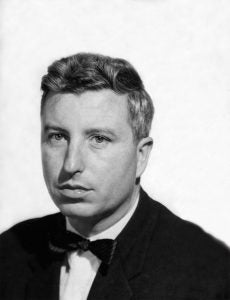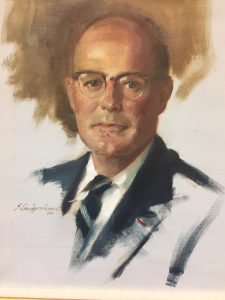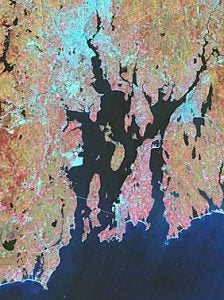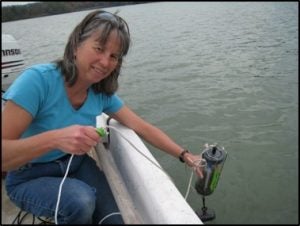Probably all South County residents and many of its visitors have driven to where South Ferry Road dead ends at the Bay Campus Beach. Here, in one view, we can see two features that characterize the Graduate School of Oceanography ( see photo to left). Glancing to the right, we see the GSO pier (or dock). This is the home port of the Research Vessel (R/V) Endeavor. But she is not the first ship to call it home. We have had an ocean-going research vessel ever since 1961 when we expanded from the Narragansett Marine Lab, a section of the College of Arts and Sciences headed by a Director, to the Graduate School of Oceanography, a unit of the University of Rhode Island (URI) headed by a Dean. Having such a ship berthed at GSO is one of the distinctions that helps GSO stand out from other marine institutions. And having a ship was one of the expectations of both the founding Dean, Dr. John A. Knauss, and the person who hired him, URI President Francis H.Horn. Their shared vision has made GSO what it is today.

Courtesy of GSO Archives
To understand how an ocean-going ship came to be in Narragansett (figuratively and literally), one needs to go back and look at the history of the Bay Campus. When in 1960 the Director of the Narragansett Marine Laboratory, Dr. Charles Fish, announced he wanted to step down as director, plenty of people could have taken his place and continued the success of the Marine Lab. The scientists there were doing research on Narragansett Bay, the coastal ponds, Narrow River, and were also doing open ocean work when they could go out on cruises or have samples shipped to them. But the Chair of the search committee, URI Dean of Graduate Studies, Ernest Hartung, said they were not interested in candidates that would “maintain the status quo”, they were interested in expanding. The name of John A. Knauss (see photo to right ), who received his Ph.D. from Scripps Institution of Oceanography the previous year (1959), was brought to the attention of the committee and John was asked if he would consider taking the position. His reply on January 23, 1961 was nothing short of visionary (how many people are thinking like this a year after achieving their Ph.D.?):
“Research in oceanography is going to grow in the next decade, and I am quite certain this means the development of one or more major oceanographic laboratories of a size comparable to the present Scripps Institution of Oceanography and the Woods Hole Oceanographic Institution…I think it is likely that these major institutions will grow from existing laboratories, and, furthermore, that they will be connected with universities…By ‘major institution’ I mean one with an annual budget of two to three million dollars and with one or more oceanographic vessels that can, and do, go anywhere on the world’s oceans. I assume, of course, that this institution would be as good as Woods Hole or Scripps, I hope it might be better.”
The President of URI, Francis H. Horn (see photo below), offered the position to John Knauss in a letter dated April 24, 1961:

“We are interested in having you come here because we are impressed not only with your scientific knowledge, your reputation, and your potential as an administrator, but because of your vision of what we can develop here by way of a major oceanographic research institution”.
And on April 27, 1961 (57 years ago), John Knauss replied:
“I am very pleased to accept the position of Dean of the Graduate School of Oceanography under the terms outlined in your letter of April 24.”
As mentioned in my previous (B)log, the Dean-Elect, Dr. John A. Knauss left California aboard the R/V Trident, a 180 ft Army supply and maintenance ship that was repurposed and renovated as a ship for oceanographic research and they both arrived in Narragansett in January 1962. The R/V Trident served GSO very well until she was retired in 1976 when the R/V Endeavor, a ship built and designed for oceanography, arrived at GSO. The vision of both John Knauss and Francis Horn had been realized.
There was one other topic in that April 24th letter sent by President Horn:
“We have indicated to you that we wish to expand our activities in to the open ocean, which is where your major interest lies; on the other hand, we must emphasize once again that as a state institution we have an obligation to serve the particular interests connected with our own coastal waters. You have indicated in your conversation with me that you are aware of this and that you expect the program to be strengthened in all areas of its interests.”

Courtesy of Y.Q.Wang, URI
And Dean-Elect Knauss replied in his letter of April 27:
I realized that in conversation with you and other members of the University I repeatedly emphasized my ideas on building the Narragansett Marine Laboratory into a major oceanographic institution…However it was not my intention to give anyone cause for alarm in suggesting that “open ocean” work should be done to the exclusion of all else. There are many important problems concerned with coastal and estuarine waters, and in a state which appears to be roughly thirty percent sea water, I know that these problems are not only of scientific importance, but they are often of economic importance as well. I want to assure you that I will do what I can to strengthen the work of the Laboratory in local waters also.”
Dean Knauss was true to his word and he assembled a faculty with expertise not only in open ocean work, but in coastal and estuarine research. In February 1975 he was quoted in the URI student newspaper, “The Good 5¢ Cigar” as saying “We’ve put together as much knowledge on Narragansett Bay as any estuary in the world” (see map).
Which bring us back to the view at the Bay Campus Beach mentioned at the start of this (B)log. As stated above, there are two features that characterize GSO. One is to the right, our open ocean research vessel. The other is directly ahead, our estuary, Narragansett Bay. And on April 27, 1961, with the acceptance of the offer of our first dean, the Graduate School of Oceanography was launched and on its way to becoming a major oceanographic research institution.
Volume 1; Number 2
For further reading on these topics and more photos, check out
For the early history of GSO, the R/V Trident, and the R/V Endeavor, see the Providence Journal and Providence Evening Bulletin entries in the scrapbook: “History of GSO, Fishes, Fire, and South Ferry Church” assembled by Joyce A. Downey, Coordinator of Library Services, and located in the Pell Library. See also dates on https://web.uri.edu/about/history-and-timeline/
To view the correspondence to and from John Knauss, see “An Offer Made and Accepted” in Aboard GSO, Fall 2016, a publication of the Graduate School of Oceanography. This can be viewed or download at: https://web.uri.edu/gso/aboard-gso-special-issue-fall-2016/
 This blog post was written by Veronica M. Berounsky, GSO Science Correspondent. She first arrived at GSO in March of 1979 as a research lab tech. In 1990 she obtained her Ph.D., working on nitrification in Narragansett Bay with the late Scott W. Nixon. She continues to be fascinated by the ecology of coastal ecosystems every day. With this blog she hopes to increase your understanding of the activities and people of GSO and the Narragansett Bay Campus. Please email any comments to her at vmberounsky@uri.edu.
This blog post was written by Veronica M. Berounsky, GSO Science Correspondent. She first arrived at GSO in March of 1979 as a research lab tech. In 1990 she obtained her Ph.D., working on nitrification in Narragansett Bay with the late Scott W. Nixon. She continues to be fascinated by the ecology of coastal ecosystems every day. With this blog she hopes to increase your understanding of the activities and people of GSO and the Narragansett Bay Campus. Please email any comments to her at vmberounsky@uri.edu.
Or click here to see all previous Bay Campus (B)logs.
